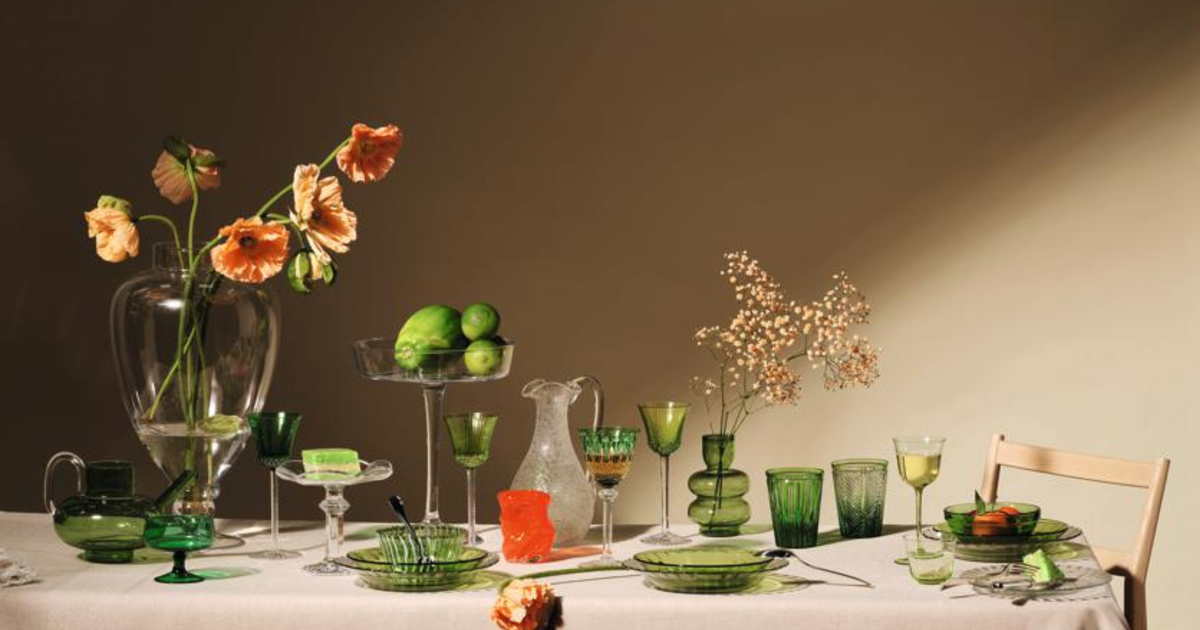A big hard rock sound comes out of speakers attached here and there to metal pillars. A musical background chosen by the women and men who tame the molten glass in the hot workshop of the Saint-Louis crystal factory. We did not expect such an atmosphere or even to see a team made up of many thirty-year-olds officiating in this factory which is celebrating its 438th anniversary. And if the atmosphere is calmer in the cold workshop, where each piece is cut and engraved, the different generations also cooperate harmoniously. Obviously, Saint-Louis is not having trouble recruiting.
This is confirmed by Jérôme de Lavergnolle, its CEO: “The average age in the production workshops is 38 years old. It's quite young. It is, in fact, fundamental to maintain a pyramid with a good balance, otherwise our know-how would be doomed to disappear. Transmission is at the heart of our businesses. Diversity is also important. In total, we have 40% women and 60% men. It’s not yet parity, but we’re moving forward.” The interest of blowers and cutters in manufacturing is a godsend because the order book is overflowing.
A new oven will even be inaugurated in July to meet growing demand. “We have, in almost four years, almost doubled our turnover,” explains Jérôme de Lavergnolle. No doubt, crystal is popular! And this is undoubtedly due to a creative dynamism which involves a diversification of ranges and collaborations with prominent designers, such as Noé Duchaufour-Lawrance or Pierre Charpin. This bridge, between the need to preserve techniques, but also to develop them, is what underpinned the birth of Cirva (International Center for Research and Innovation on Glass and the Plastic Arts), in Marseille.
Open-mindedness
“We are the fruit of the marriage between Jack Lang and Louis XIV,” laughs Stanislas Colodier, who directs this non-profit association recognized as being of general interest. It was, in fact, Jack Lang who was at the origin of Cirva in 1983, as part of a plan for glass. This initiative was in line with the Colbertist tradition, a commitment by the French state to the arts and crafts. But our form, an art center geared towards experimentation, is completely original. The glass artisans who work here are extremely open-minded and have one goal: to take artists on an adventure with a material they are unfamiliar with.” The Cirva has, without a doubt, been a locomotive for reconnecting design, art and glass. A reunion also facilitated by two openings: that, in 1991, of Cerfav (European Center for Research and Training in Glass Arts) in Vannes-le-Châtel, in Meurthe-et-Moselle, and that, in 1992, of Civa (Centre international glass art) on the site of the Meisenthal glassworks, in the Northern Vosges, which was founded in 1704 and closed in 1969.
An art that sublime
In all these structures, we are delighted with the classification of the glassmaking gesture as an intangible cultural heritage of humanity by UNESCO in December 2023, but also in all French manufacturers – Saint-Louis, Baccarat, Lalique, Daum – and among artisans who see their profession as classified as a treasure. A treasure maintained, according to the Crystal and Glass Federation, by four thousand men and women in France. Maggie Henriquez, general manager of Baccarat, sees this recognition as new challenges to overcome.
“It is our responsibility to project crystal into the future by highlighting young artists and thinking about new uses. Mixology, for example, interests us. It’s a way to reach young people, to take the complexity out of buying crystal and to show that it can change everything in a tasting.” Because Maggie Henriquez is sure of it: crystal enhances everything, even the simple gesture of drinking a glass of water, its beauty residing in particular in its way of capturing and reflecting light. A form of magic that goes hand in hand with durability, because glass can be remelted, transformed and rarely corrupts over the centuries.
The mix and match spirit
If there is one piece that has stood the test of time, it is the Duralex Nesting Cup. Far from the gold of palaces, its reputation has been forged in canteens since its launch in 1946. “From the 1950s to the 1970s, many of us looked at the number at the bottom of the glass to find out how old we were,” says Mélanie Lebranchu, France marketing director of Duralex. If the 1990-2000 period was more difficult, we have now regained momentum.” Both the Gigogne and the Picardie, a nine-faceted superstar, are shipped to more than 240 countries.
And not just in canteens, but in stores as demanding as that of the Center Georges Pompidou, in Paris, or the MoMA, in New York. “To wake up this sleeping beauty, we had to go through innovation around, for example, color and capacities, because we have to offer solutions for different uses, such as the consumption of cocktails. Generally speaking, we have a complete offering, from salad bowls to glasses, including plates and bowls… which work very well in mix and match.”
Break the codes
The formula is pronounced: mix and match. A study carried out in August 2023 by the YouGov institute for Duralex shows that 73% of French people are fans of mixing styles when it comes to tableware and that 80% of 25-34 year olds believe that a table can be set with several styles of tableware. dishes. There is therefore no longer anything surprising to see, side by side at dinner time, a Picardie and a Bubbles stemmed glass from Saint-Louis or a Massénat from Baccarat. Restaurants are the first to set an example like Sapid, an address in the Ducasse galaxy, where you eat in Gien porcelain and drink in a Gigogne. So rather than breaking glasses, we have fun, without hesitation, in breaking the codes.

